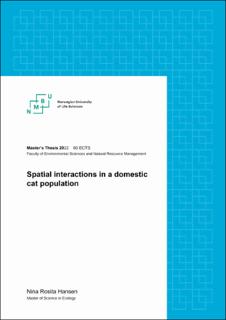| dc.description.abstract | The domestic cat (Felis catus) is one of the most popular pets globally, with hundreds or even thousands of individuals per km2 in some areas. Domestic cats with outdoor access have both direct effects on wildlife through predation and indirect effects on wildlife through intimidation that alters prey behavior. Knowledge about space use by outdoor cats is important for understanding and mitigating their ecological impact. Little is known of how intraspecific interactions affect space use in cat populations. Yet, cat tracking studies typically include too few individuals or are spread across study areas that are too large to provide reliable inferences about intraspecific interactions.
In this study, I investigated the impact of intraspecific interactions on the combined space use of a cat population using GPS-tracking. This was made possible by the unprecedented high proportion of GPS-tagged cats: 75% of cats (n = 95) living in a 1.1 km2 suburban neighborhood in Southern Norway. I used high-throughput GPS position data and analyzed it with a combination of Brownian Bridge Movement Models and an ecological null-model to assess the role of intraspecific spatial interaction on space use in the study population.
I found evidence that cats of both sexes tend to avoid conspecifics. This effect was particularly pronounced for females. Individuals less than 8 years old, regardless of sex, exhibited lower home range overlap with other individuals than older cats. I also detected indication that intraspecific avoidance led to a more widely spread population-level space use than would be expected by chance. In addition, I found that males had larger home ranges than females, and that cats below 8 years had larger home ranges than cats 8 years or older.
To my knowledge, this is the first study that explored the population-level manifestation of intraspecific interaction and its consequences for the spatial configuration of a free-ranging pet cat population. From my study, I conclude that age and sex explain the propensity of domestic cats to avoid each other, as well as the variation in home range size of domestic cats. This, in turn, will determine the overall space used by the population. Now, more studies are needed to investigate interactions and their ecological role, as intraspecific interaction is an important mechanism behind density-dependent effects. | |
